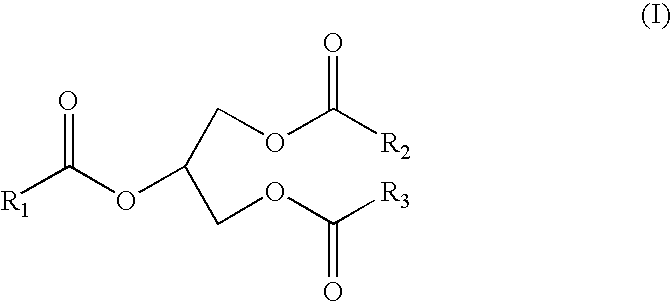Fuel composition for a diesel engine
a technology for diesel engines and fuel compositions, applied in the direction of fuels, lubricant compositions, biofeedstocks, etc., can solve the problems of poor miscibility of diesel fuels, poor storage stability, poor performance at low temperatures
- Summary
- Abstract
- Description
- Claims
- Application Information
AI Technical Summary
Benefits of technology
Problems solved by technology
Method used
Image
Examples
example 1
[0034] The following Table 2 compares the emission characteristics of a conventional diesel fuel used in Europe in summer, EN 590 (DI), to those of a composition containing 60% by volume of hydrogenated and isomerized tall oil (TOFA), and 40% by volume of the European summer diesel fuel EN 590.
2TABLE 2 Characteristic Unit 60% b.v. TOFA + 40% b.v. DI DI Turbidity point .degree. C. -15 -8 Cetane number -- 61.2 55.9 Aromates % b.w. 8.7 19.2 Total aromates (IP391) % b.v. 9.1 20.0 Polyaromatics (IP391) % b.v. 0.8 1.6 n-paraffins % b.w. 14.7 24.5 i-paraffins % b.w. 34.2 26.1 Naphthenes % b.w. 42.4 30.2 b.w. = by weight b.v. = by volume
example 2
[0035] Table 3 below compares the emission characteristics of a high quality reformed crude oil based diesel fuel available on the Finnish market (DITC, produced by Fortum Oyj), to those of compositions containing 30% by volume of hydrogenated and isomerized tall oil (TOFA), and 70% by volume of DITC, or containing 30% by volume of tall oil methyl ester (MME), and 70% by volume of DITC.
3TABLE 3 30% b.v. TOFA + 30% b.v. MME Characteristic Unit DITC 70% b.v. DITC 70% b.v. DITC Cetane number -- 51 57 48 NO.sub.x emissions % -1 to -4 +3 (compared to DITC) Particles % -3 +22 carbon % -10 to -30 0 to -10 PAH % .+-.0 .+-.0 Combustion decreases .+-.0 noise b.v. = by volume
PUM
| Property | Measurement | Unit |
|---|---|---|
| Percent by volume | aaaaa | aaaaa |
| Percent by volume | aaaaa | aaaaa |
| Percent by volume | aaaaa | aaaaa |
Abstract
Description
Claims
Application Information
 Login to View More
Login to View More - R&D
- Intellectual Property
- Life Sciences
- Materials
- Tech Scout
- Unparalleled Data Quality
- Higher Quality Content
- 60% Fewer Hallucinations
Browse by: Latest US Patents, China's latest patents, Technical Efficacy Thesaurus, Application Domain, Technology Topic, Popular Technical Reports.
© 2025 PatSnap. All rights reserved.Legal|Privacy policy|Modern Slavery Act Transparency Statement|Sitemap|About US| Contact US: help@patsnap.com

